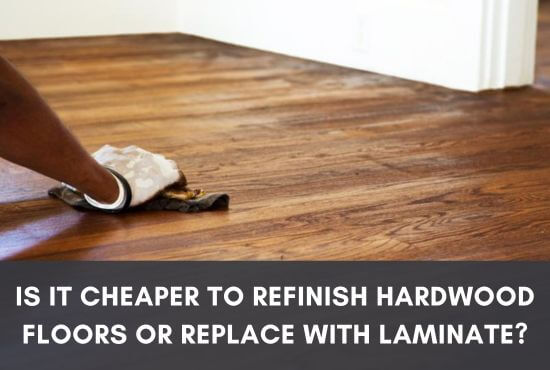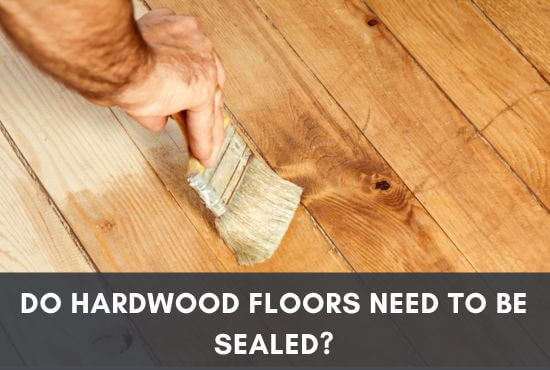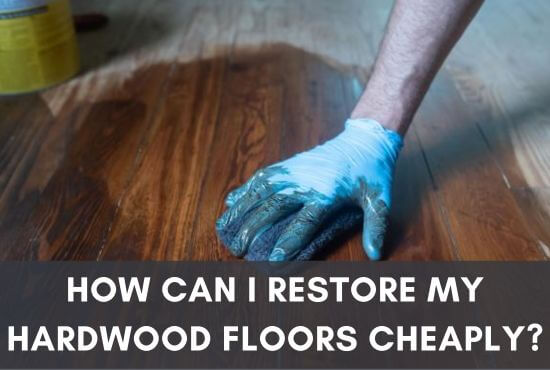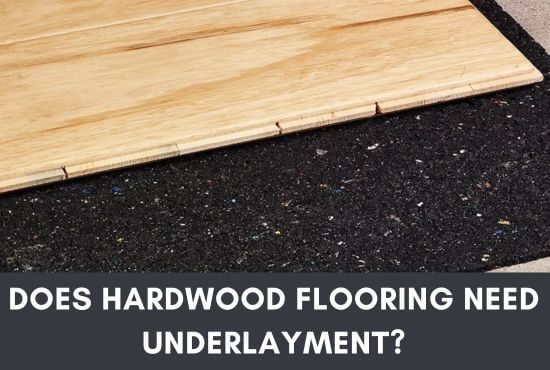Hardwood floors can face a lot of damage over time, which can be increased severely if not cared for.
Many homeowners either don’t give proper attention to their hardwood floors or are not present in the house for an extended time which results in the deterioration of the floors.
As a result, many people, when they find their hardwood floors ruined, ponder whether it is a good idea to get their hardwood floors restored or not.
It is worth repairing and restoring your hardwood floors rather than replacing them. Restoration of your hardwood floors depends on your personal decision; however, if the extent of damage is too much, restoring the floors might cost almost the same as replacing them with new floors.

In such cases, you should look forward to getting new flooring rather than repairing and restoring the old one. But, I will discuss many factors involved in making this decision shortly.
Table of Contents
Factors Affecting Restoration
There are various factors that determine whether you should restore your hardwood floors or not. It is crucial to identify these factors and decide accordingly, as at the end of the day, you decide to make.
Below are some of the factors you should look for if you want to know if it is worth it to restore your hardwood floors.

Type of Damage
There are various ways in which hardwood floors can be damaged, and each one of them is a different scenario that needs to be dealt with differently.
While water damage remains the root cause of almost all types of damage to hardwood floors, some other factors need serious attention, whether you want to restore or replace your hardwood floors.
Despite having your floors stained and sealed, you can still face problems through water damage, such as:
- Buckling (If you are worried about buckled hardwood floors, I have written a whole article on replacing buckled hardwood floors.
- Cupping
- Stains
- Mold
- Bouncy floors
In usual cases, repairing hardwood floors with water damage is nearly impossible and not recommended.
Water damage causes disfigurement to the hardwood floors and gives them resistance against any repair or restoration attempts.
Besides, even if you succeed in somehow restoring the hardwood floors to some extent, you won’t be able to get them back to their original form.
Moreover, if infestations damage your hardwood floors, wear and tear, or moisture, there is still a chance that your hardwood floors can be repaired and restored, provided the root cause was identified in the early stages.
Besides, dents and scratches on your hardwood floors are also something you should be reassured about.
Restoration can easily make your hardwood floors revert back to their original form, so you don’t have to worry about getting them replaced for a minor issue.
Extent of Damage
The amount of damage your hardwood floors have received is also a major deciding factor on whether you should restore your hardwood floors or not.
If the damage is severe but restricted to a certain area, for instance, a single room or a few planks, you can easily replace the severely damaged boards and restore the others.
However, if the entire house’s flooring has received considerable damage due to any reasons, such as water damage or infestations, it is best not to waste your efforts on such scenarios.
Replacing the hardwood floors is the most suitable decision at this moment.
Another factor to be kept in mind is that the hardwood floors should be repaired in such an order that their color and grain are restored.
Moreover, if you are replacing a few planks and restoring others, you must ensure that the new boards match the specifications of the pre-existing ones.
Although finding a perfect match for aged wood is almost impossible, find the closest ones and try to stain them correctly, so they have the same qualities and features as the old planks.
In addition, if your hardwood floors have received general wear and tear, you can easily restore them, and there is no need to get a replacement altogether.
Also Read: How Often Should You Clean Hardwood Floors (Revealed)
Visual Preferences
The type of look you want on your hardwood floors is a major determining factor as to whether you should restore hardwood floors or not.
As mentioned earlier, it is impossible to match the new wood with aged wood as the grain, texture, and color would differ.
Aged wood has reached its mature texture and color through the actions of wear and tear and other factors such as weather.
However, new wood can’t be matched with this, and it would take much time before it gets blended into the appearance.
Moreover, if your hardwood floors are antique and there is a dark stain or an old look you like, it is impossible to find anything close, as contemporary designs do not follow the same texture or grain nor age the same way.
The same is the case when your existing hardwood floor is light in color, and you don’t want to mix it up with a darker wood tone.
In short, if you want to maintain the old wood’s look, you must go for restoration, as a replacement would not be your forte.
Conversely, if you want an even tone on your hardwood floors, even though it is new or old, it is better to opt for replacement, as this way, you can get the same panels for all your surfaces. However, if you don’t intend to replace or restore, you can also try to perk up old hardwood floors naturally.
Repair Options
You can repair and restore hardwood floors in many ways, and partial replacement is the most astounding option.
This practice involves removing and replacing severely damaged floors with new and durable planks that match the color tone of the existing boards.
Furthermore, the color pallet can be matched by using reclaimed lumber. This way, you can replace only a few planks or flooring in one room rather than replacing the entire house’s flooring.
This method works even with old or extinct wood types which are not commercially available anymore, as the reclaimed lumber can allow for color matching to an unbelievable level.
However, you can’t expect the same grain and texture as the age and wear and tear received are different for both kinds of wood.
Partial replacement is a suitable way to save you a lot of time, effort, and money, but it is a tricky task.
Performing this procedure by yourself is very difficult, and unless you have honed skills in carpentry, it is best to take help from a professional.
If your hardwood floors have received only minor damage and regular wear and tear, the current state may have been achieved due to a lack of proper care.
In such scenarios, refinishing your hardwood floors is a suitable option.
It starts by ending, removing all the excess layers of dirt and grime built on your floors and allowing the pores to be reopened so the wood can breathe again.
Once the surface is clean and shiny, the hardwood floors are again stained for further protection against scratches, dust, dirt, and other wear and tear factors.
Besides, restaining is also helpful in matching the colors of your old, and new hardwood planks, and a few sessions of refinishing can ensure that your hardwood floors look the same more or less.
You can either hire a professional for this job or take up this task yourself if you want. Hiring a professional might cost you a bit more, but the project will be completed much faster, and there will be little margin for failure.
On the contrary, the DIY approach also has numerous benefits you might want to avail of.
Firstly, it will save you much money compared to hiring professional services, as all you would need to spend is a few bucks on sanding and staining materials.
If you want to take it a step ahead and achieve professional-level precision, you can rent a sanding machine that will save you a lot of time and effort and ensure that your hardwood floors are cleaned thoroughly.
Almost all home improvement stores can rent these machines at affordable rates.
Moreover, DYing the project can also give you a lot of insight into how to keep your hardwood floors clean and maintain them properly, so they don’t meet the same fate again as they have now.
Don’t Miss: What Not To Use On Hardwood Floors?
Replacement Options
If you are looking forward to replacing your hardwood floors, there are mainly two options you can choose from.:
- Full-thickness hardwood (usually ¾ inch thick)
- Engineered hardwood flooring (½ thick hardwood base)
Despite the species or category you have chosen for your hardwood floors, you will have these options in almost all of them.
Besides, they also come in various colors, so you don’t have to worry about getting the right matching color for your floors.
It is not recommended to take this project yourself as it is very complex and involves too many risks.
Not only is it difficult to execute, but there’s always a risk of your neighboring boards getting damaged during the removal process.
Moreover, it requires a lot of time, even for professionals, which means that a newbie performing this task can take weeks to finish the job.
Depending on the size of your replacement project, the time may even be increased to a month or more. Both of these wood types provide the optimum level of protection and have decent appearances.
At the same time, hardwood offers you a pure wood experience (if it is not treated) and has a thickness of almost ¾ inches.
In comparison, engineered hardwood is a compound with many inorganic materials for added strength and durability.
It offers ½ inches of thickness at the base, made from hardwood, while the rest of the compound is laid on top.
Is It Better To Refinish Hardwood Floors Or Replace Them?
Restoration and refinishing are always preferred over replacement as it is easy, time-saving, and budget-friendly in most scenarios.
Moreover, you have selected your flooring in contrast with your walls or furniture, and it might be hard to get the same color when trying to replace the flooring.

In such scenarios, restoring helps a lot, whereas replacing can reset the entire color combination of your house.
Choosing whether to replace or restore involves giving thought to many factors, such as:
- Weighing damage
- The desired look
- The options at hand
For instance, it is always recommended to replace your hardwood floors if they have been damaged by water or infestations, as damage from such sources causes the wood to lose its shape and strength, and there is no way the wood can now be restored to its original form.
On the other hand, if the wood has only faced cosmetic damage or has been roughed up a bit due to the constant traffic it has received, it is always recommended that you get your hardwood floors repaired rather than spending thousands of dollars on a replacement.
As mentioned earlier, you need to replace your hardwood floors if you want a lighter look and the floors have turned too dark after the damage and the time they have spent.
In addition, if you enjoy the vintage dark stained look, you can either restain and refinish your hardwood floors and if that does not work, you should move to further in-depth restoration as a replacement would not be suitable for you.
Again, if you are keen enough, all of these procedures can be performed by a hired professional or yourself.
Both of these have their pros and cons, which were mentioned earlier, so choose what suits you the best.
You May Also Find Helpful: The Surprising Way Vinegar Can Damage Your Wood Floors
Can Old Hardwood Floors Be Restored?
If your hardwood floors are old and damaged, you can give them a facelift by looking after only a few factors.
For instance, hardwood boards that have succumbed to infestations can be replaced if they are fewer in number.
Planks that have lost their finish due to excess traffic and extreme pressure can be refinished or restained to retain their luscious look.

Moreover, if your hardwood floors have been damaged due to subflooring issues, they can also be fixed.
For instance, if you face problems such as lifting, crowning, or cupping, you can easily solve these by gluing or nailing the boards back to the subflooring surface for a better grip.
Moreover, if certain areas on each board are damaged, they too can be patch repaired. The patches can be found in varieties of colors, species, grains, and textures to match the original appearance of your hardwood floors.
In addition, if you have seen tough and stinky stains on your hardwood floors due to spillages or pet urine, they can be fixed with hardwood floors deodorizing and cleaning methods using natural or commercial solutions.
Moreover, such outcomes can be avoided by using rugs or carpets in high-traffic areas for your hardwood floors.
Hence, it is always better to consult a professional before replacing or restoring your hardwood floors.
In most cases, you may know whether there is a restoration method for the damage your floors have received.
And due to this lack of information, you might start a replacement project which can be totally unsuitable for your hardwood floors.
Is It Cheaper To Refinish Or Replace Hardwood?
The cost of replacing a hardwood floor is much higher than restoring one.
The main reason lies in the lengthy process, which involves many stages, such as removing the old planks, reconditioning the subflooring, installing new hardwood boards, and sanding and sealing them if necessary.
Besides, this doesn’t even include the cost required of labor and other charges such as transportation of material, etc.

All of this combined can make the project too expensive and hence, not recommended. Refinishing your hardwood floors is a fairly cheaper option, costing only around 3-8$ per square foot.
This means that refinishing a single bedroom will cost you around $300 to $800, whereas the project of an entire house can range from $2400 to $6000.
Compared to the replacement cost, it is quite cheap as replacing costs around $6-$18 per square foot.
A single room can cost around $1200 to $3600, whereas replacing the hardwood floors in the house will cost between $12k to $36k.
Moreover, the longevity of wood is not to be joked about as it can last you 2-3 decades easily with proper care.
You can sand and refinish the hardwood floors at least 6-7 times, where the average duration between each refinishing process will be approximately 2 years.
Hence, it would not be very intelligent to replace your hardwood floors when they can be restored. Consult a professional before saving yourself much money and avoid getting a hefty bill.
In most cases, restoration and refinishing are possible, so make sure you analyze the situation first, as replacing might sound like a fun task to do, but it is very hectic and troublesome even if you have the necessary means available.
How Do I Know If My Wood Floor Is Worth Refinishing?
Hardwood floors must be refinished once they show excessive scratches or dents and become dull permanently. Certain signs you must look for will tell you that it is time to refinish your hardwood floors. These indicators include:
- A high number of scratches and scuff marks on the surface are becoming prominent by the day.
- Dents or dings caused by falling heavy objects, increased traffic, or pet claws do not go away after the wood conditioning processes.
- A worn-out look that makes your hardwood floors appear dull and does not go away even after numerous cleaning and polishing sessions.
If you find these signs on your hardwood floors, please be aware that these are only indicators of a new finish requirement.
Finding these signs on your floors does not mean it is time to replace your hardwood floors.
A simple sanding session and reapplication of your preferred stain or sealant will be good enough to counter these factors.
You’re only looking for cosmetic fixes. If you want to restore your floor’s original luster and shine, simply buffing and refinishing them is a great way to rev up their aesthetic appeal without breaking the bank.
If you want the wet shine look, you can learn from this guide how to make hardwood floors shine like they are wet.
When Is It Worth It To Replace Hardwood Floors?
It is best to replace hardwood floors if they have become squeaky, started to warp, or have buckled intensely. You can also fix squeaky hardwood floors if you are on a tight budget.

Such situations call for replacement, be it complete or partial. Here are a few indicators that you should look for:
- Your hardwood floors have started to squeak and creak to the point where they shake when pressure is applied to them. To learn more about shaking wooden floors and their solutions. I encourage you to read this in depth-guide on why my hardwood floor shakes when I walk.
- The floors have started to warp, possibly crowning, and lifting is also taking place to the extent where the planks are coming off.
- The subfloor has deteriorated and can’t hold onto the planks anymore, causing lifting, warping, and other problems.
- If you have engineered/synthetic wood, you won’t be able to sand it down as they are a composite material with many layers. The top layer is mostly veneer to prevent decay, because of which sanding becomes ineffective. Besides, engineered or synthetic wood is very thin and is mostly treated which can result in toxic fumes when sanded.
- The thin structure of engineered or synthetic wood makes it hard to refurbish, making it unsuitable for restorations.
- If the hardwood floors are extensively damaged, restoration can’t help them return to their original form.
- The flooring has become unstable and poses threats of collapsing under your feet at any time. This can be experienced in the form of severe shaking and vibrations when you walk on the floors.
- Extreme movements between the boards make the floor feel like a boat on the water and deny any stability on the platform.
- If the floor has been sanded many times, causing a condition known as “no meat left in the wood”, where all the possible shavings have been sanded off and the nails and grooves are getting exposed at this point. Generally, if 30% of the floor has been sanded off (30% of the thickness), you mustn’t move to further sanding or refinishing.
If you observe any of these signs on your hardwood floors, it is best to revert to a professional rather than attempting anything yourself.
Hardwood floors with conditions similar to the pens mentioned above are very complex cases and are supposed to be dealt with extreme care.
If you need to be more skilled in carpentry, you might ruin your floors, and the cost of repairing or reconstructing structures, such as the subflooring, will also be added to your invoice.
Hence, you must contact a flooring specialist immediately to avoid unnecessary inconveniences and bills.
Bottom Line
Restoring your hardwood floors is a fairly simple task, and if your floors have been damaged for years, you should consider restoration and refinishing.
Hardwood floors do bear much damage mainly because it is literally in their job description as they are meant to be walked upon.
However, untimely care can ruin your hardwood floors and increase the wear and tear they must take. In such situations, one always needs clarification on whether to get the floors restored or replaced.
The best solution is to seek help from a professional and make restoration your primary objective.
If the restoration fails or isn’t possible due to the above-mentioned reasons, you can think about replacing the old and worn-out hardwood floors with new ones.

As a co-creator of FlooringFlow.com, Emma Sophia comes on board to answer all your questions related to any flooring problems. Together with John Henry, she’s gained extensive experience in fixing many flooring problems in their own house as well as in friends and family’s. Now, she wants to share her knowledge that she gained during floor remodeling, restoring, and DIY projects.







